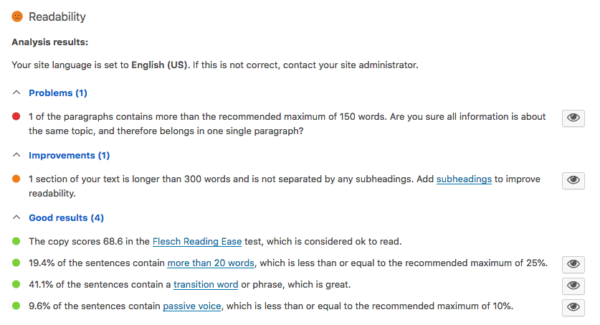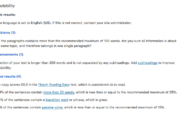Reading from a screen can be difficult, so if you want people to read your whole blog post, it must be easy to read. This will get you more returning visitors and a higher conversion rate. Luckily, improving the readability of your content is something you can do relatively easily, to give your site a quick boost during these difficult times. This post gives you five top tips for writing readable articles. To make improving readability even easier, Yoast SEO offers a readability check! It’s available in several languages and we add new languages regularly, check out which features are available in your language.
Focus on your audience
Remember the most important advice I can give you: Make sure your text is pitched at the right level for your audience. If you write about LEGO and your content is aimed at kids, then it should be really easy to read. But, if your audience is scientists with a Ph.D., your text can be much more challenging and still be appropriate. The five tips below should, therefore, be seen as guidelines. For some audiences, text could be made even simpler, while for other audiences the rules will be a little too strict. If you’d like to dive a little deeper into the art of copywriting for both people and SEO, consider taking our SEO copywriting course, part of our Yoast Academy training subscription.
Read more: Readability: Dumbing down or opening up? »
Tip 1: Write clear paragraphs
Make sure you write clear paragraphs. For a blog post, we advise you always start a paragraph with the most important sentence, then explain or elaborate on that sentence. This helps a reader to grasp the concept of your article, just by reading the first sentence of each paragraph. Make sure your paragraphs aren’t too long either (7 or 8 sentences is quite long enough).
Tip 2: Write short sentences
Try to write short sentences. Shorter sentences are easier to read and understand than longer ones. Also, you’re likely to make fewer grammatical errors as your sentences are nice and short. We consider sentences containing more than 20 words to be too long. If you’re writing in English, make sure you only have a few sentences of 20 words or more in a blog post, but each language has its own limits. Also, make sure paragraphs don’t have more than one long sentence each.
Tip 3: Limit difficult words
Limit the use of words that are difficult to read. Remember that reading from a screen is harder for everyone. Words with four or more syllables are considered difficult to read, so avoid them where possible.
Of course, sometimes your blog post is about something that’s hard to explain or requires a more advanced vocabulary. For example, I wrote a post about illustrations. The word ‘illustrations’ has four syllables and can be seen as a difficult word, but I still had to use it (and quite often too). In cases like this, make sure your sentences and paragraphs aren’t too long, and your readers will still be fine!
On a side note, unless you’re focusing on a niche market, difficult words usually make less useful focus keywords for a page. In the example above, ‘images’ or ‘visuals’ might have been a better choice. Remember the most important thing is that your focus keyword fits the subject of the post. Proper keyword research will give you better alternatives for difficult keywords.
Tip 4: Use transition words
You can make your writing much more readable by using proper transition words (or signal words – the same thing). Transition words are words like ‘most important’, ‘because’, ‘therefore’, or ‘besides that’. They give direction to your readers. These words give a signal that something is coming up: if you’re summarizing, you’ll use ‘first’, ‘second’, ‘third’, etc. If you want to compare, you’ll write ‘same’, ‘less’, ‘rather’, ‘while’ or ‘either’. If you want to conclude, you’ll use ‘hence’, ‘consequently’ or ‘therefore’.
Using transition words is a bit like putting cement between your sentences. The relationship between two sentences becomes apparent through the use of transition words. Readers will understand your content much better if you use these kinds of words properly.
Tip 5: Use variation!
For a piece to be attractive to a reader, it should be varied – you should try to avoid repetition and shake things up a little! Alternate longer paragraphs and sentences with shorter ones and try using synonyms if you tend to use a particular word too often. Some people use the words ‘and’ or ‘too’ a lot. Mixing these with words like ‘also’ or ‘moreover’ could make your writing more attractive – and much more readable too.
Use Yoast SEO
To help you write readable copy we offer a readability check in Yoast SEO. It checks the length of your sentences and paragraphs, and whether you use transition words or subheadings. What’s more, it assesses your use of passive voice. It also calculates the Flesch Reading Ease score of the piece, a formula that indicates how easy to understand your text is. Check out the readability score of this text

Conclusion
If you want your readers to get to the end of your blog post, make sure that your text is easy to read. Don’t make your text more difficult than you have to. Avoid long sentences and write clear paragraphs. Tools like Grammarly and Hemingway can help you to write more readable text. And, if you use our Yoast SEO plugin you get a readability check on your content as well, so you’ll be able to check whether your writing is SEO-friendly and readable at the same time!
Keep reading: Blogging: the ultimate guide »
The post 5 tips for writing readable blog posts appeared first on Yoast.


